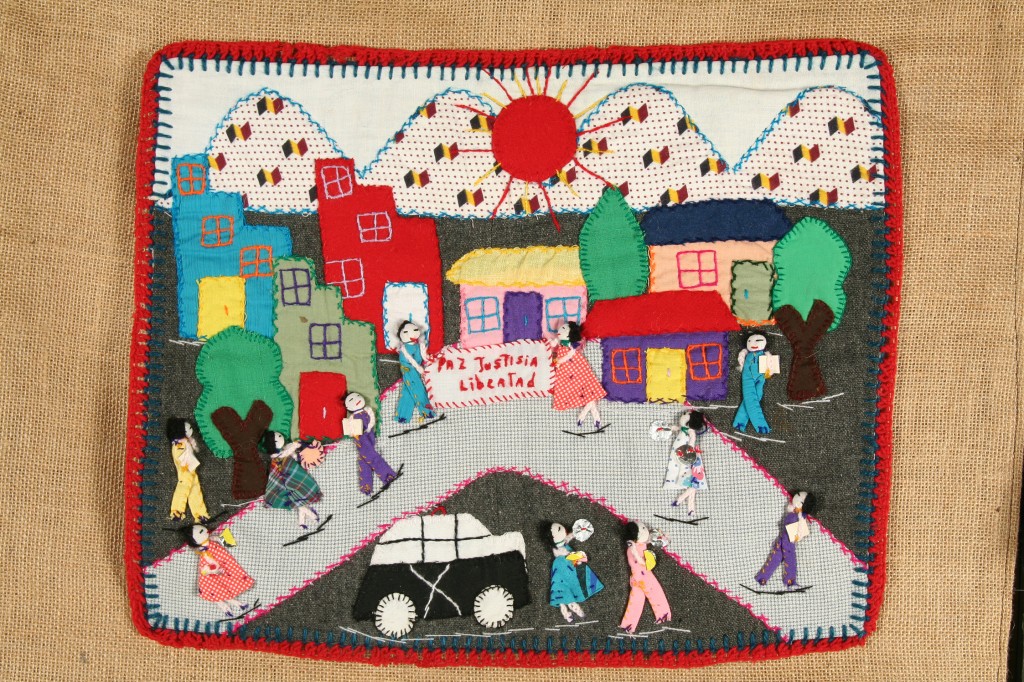
The earliest proponents of the growing field of peace studies were well aware that their work had as much to do with provoking creative nonviolent conflict as with conflict resolution. That spirit of resistance was alive and well at the University of Massachusetts Amherst last month for the traveling international exhibition “Transforming Threads of Resistance,” which brought together the weavings and stories of women from Chile and close to a dozen other countries throughout Latin America, Europe, and Africa.
Exhibition coordinator Leah Wing introduced curator and activist Roberta Bacic by noting that it is not unusual for “conflict resolution scholars and practitioners to view resistance as a barrier to conflict resolution.” This dynamic can be doubly the case after a peace accord has been reached or a dictator overthrown — when resistance “can be seen as contributing to the perpetuation of the conflict rather than to peace.” Wing argues that this narrow approach “contradicts the wisdom and life experience of most people who themselves have suffered from state violence and who have used resistance to survive and attain their freedom.”
Rooted in the traditional textile craft form known as arpilleras, the practice of stitching colorful threads or cloth onto cut squares of burlap bags has long been an inexpensive way for Chilean women to express themselves. They turn the scraps from food packaging and the torn rags of their lives into striking representations of their thoughts and dreams. During the vicious dictatorship of Augusto Pinochet — which was kicked off on September 11, 1973 by a CIA-directed coup d’etat against democratically-elected socialist Salvador Allende — the mothers, grandmothers, sisters and daughters of the so-called “disappeared” people turned their crafts into symbols of resistance. Although the official militaristic desire was for the lives and legacies of the thousands of desaparecidos to be erased, the arpilleras, then and now, graphically bring to life the struggles of the time. In this way and for these families, historical memory becomes an act of resistance and ongoing social change.
Some of the weavings from the Pinochet era — which lasted until an ever-bubbling series of nonviolent organizations and actions spurred an unstoppable wave of anti-dictatorship sentiment in 1990 — depict simple cloth dolls of women standing in a line, holding a banner with the question “Where are the Disappeared?” Some show more intense imagery, of prisoners languishing in hidden-away torture chambers or of the huge water cannons used to target those brave enough to demonstrate under incredibly repressive conditions. The protesters — often women armed with nothing more than pots and pans, clamoring for help in finding their loved ones — were not only hit with highly pressurized water making it impossible to stand or walk, but were also sprayed with colored dye, so they could be identified and rounded up even if they did manage to get away.
The spectacularly dramatic Sebastian Acevedo Movement Against Torture — named after the father who immolated himself when the Pinochet regime seized his son and daughter — gained a reputation for staging “lightening” demonstrations. These progenitors of today’s smart/flash mobs (coordinated decades before cell phones and “tweets”) brought dozens of activists into the public square, in loud calls for democracy and an end to injustice — handing out informational leaflets and giving on-lookers the courage to oppose the regime. By the time any police or military arrived, the organizers were already gone.
In finding new means of voicing protest and staging collective action through the making of political “crafts,” the women of Chile also often utilized scraps of clothing left over from their disappeared loved ones. “Thus the women used not only their material resources, but something deeper than that” noted curator Roberta Bacic — a former staff person of Chile’s Servicio Paz y Justicia (SERPAJ) nonviolence network. “They sewed their lives and their loss into the tapestries.”
Based on her work with families and former prisoners after Pinochet was forced out of office, Bacic recounted how the “apparently innocuous” became “acts of subversion.” Arpillera workshops themselves became training centers for civilian empowerment. Although a critic of the accommodation which was reached between the military and the mainstream Chilean political parties resulting in the end of Pinochet’s presidency, Bacic was appointed to the Chilean Truth and Reconciliation Commission and subsequently became a program officer with War Resisters International. Bacic’s global encounters have led her to collect textiles from other parts of the world, connecting and spreading their messages of resistance to ever-widening audiences.

Observation and gallery-gazing, of course, is far from the final goal of exhibits like these. The Amherst gathering brought together weavings from Ecuador and Colombia, as well as from Ireland and Germany, where images of devastation and genocide mixed uneasily with images of hope brought about by solidarity. West Bank weavings showcased the plight of Palestinian refugees and a tapestry from Zimbabwe served as the recorded history of “a day we will never forget,” — when attacks on a village brought untold devastation but failed in its attempt to undo the community.
Survival in bleak times must be about making these transnational solidarity connections. The arpilleras, as Roberta Bacic explains, must “act as a reminder to us of what we have, and startle us into seeing what others have lost. And in their startling simplicity, the arpilleras compel us to do something.”
